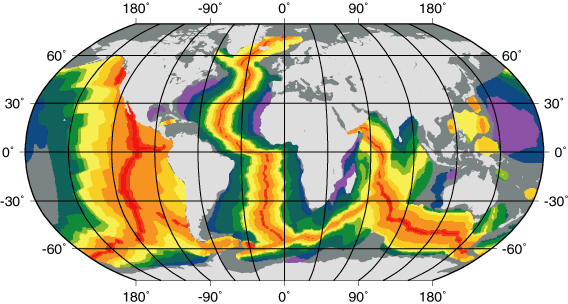 | SEDIMENTS |
Satellite altimetry |
|
terrane - http://therockstars.ucalgaryblogs.ca/yamnuska/geologic-history-and-geomorphology/ |
A Layered Earth |
possible paths of seismic waves through earth |
the age of ocean floor - blue ¢ late juristic 144-161 ma purple (green-yellow ¢ Paleocene 58-66 ma ridge ¢ Pleistocene to recent 0-1.6 ma |
|
terranes |
terranes |
Californian terrane |
Earth Quakes world data |
terranes |
|
|
|
SEDIMENT
65 million years ago on one very bad day ¢ a catastrophic asteroid strike. We have fireball layer: dust and ash fallout from the asteroid impact. Tertiary post-extinction layer: sediments containing microfossils from after the dinosaurs.
Analysis of the sedimentary material ¢ dust and gravel, salt and mud ¢ can tell us the recent history of the whole Earth. In a sense, seafloor sedimentary deposits are the memory of the ocean. Many lines of evidence suggest that Earth was struck 65 million years ago by the steroid about 10 km across. The caqtaclysmic explosion is thought to have propelled shock waves and huge clouds of seabed and crust all the Earth, producting a time of cold and dark that contributed to the extinction of many species, including the dinosaurs.
Because seafloors are recycled by tectonic forces, the oceanÆs sedimentary memory is not long. Records of events older than about 200 million years are recycled as oceanic crust and its overlying sediment reach subduction zones. The ocean has forgotten much in the last 4 billion years.
CLASSIFUING SEDIMENTS
Terrigenous sediments
Biogenous sediments
Hydrogenous sediments: authagenic sediments
Cosmogenous sediments: microtektites- glassy dust
Sediment Mixtures
THE DISTRIBUTION OF MARINE SEDIMENTS
Pelagic sediments
Neritic sediments
The Sediments of Continental Margins
Lithification (Colorado river area was formed 570 million years ago)
The Sediments of Deep-Ocean Basin
The Distribution of Sediments
STUDYING SEDIMENTS
SEDIMENTS as HISTORICAL RECORDS
Sediments near the crest of the Mid-Atlantic Ridge. The rock outcrops are dusted only lightly with sediment. Crinoids and gorgonians attach to the rocks. Brittle stars and their tracks. Rare ripples on the deep sediment. Most marine sediments are made of finer particles: sand, salt, and clay. Generally, the smaller the particle, the more easily it can be transported by streams, waves, and currents.
Well sorted sediments (where energy fluctuates within narrow limits), poop sorted sediments (in environment where energy fluctuates over a wide spectrum).
Sediment is particles of organic or inorganic matter that accumulate in a loose, unconsolidated form. Sediments may be classified by grain size or by origin of the majority of their particles.
The sediment cycle: over geological time, mountains rise as lithospheric (crustal) plates collide, fuse, and subduct. Water and wind erode the mountains and transport resulting sediments to the sea. The sediments are deposited on the seafloor, where they travel with the plate and are either uplifted or subducted. The material is eventually made into mountains again.
Rivers are the main source of terrogenous sediments. Mississippi River.
The most abundant marine sediments are broadly classified as terrigenous and biogenous. Terrigenous sediments are of geological origin an d arise on the continents or islands. Biogenous sediments are of biological origin.
Though there are expections, the sediments of continental margins tend to be mostly terrigenous, whereas the generally finer sediments of the deep-ocean floor contain a larger proportion of biogenous material.
Deep-Ocean Basins
Turbidites
Clay
Oozes (siliceous:radiolarian, diatoms, calcareous: foraminifera, pteropods, coccolithophores)
The calcium carbonate compensation deprh CCD -4, 500m (ōMarine snowö) CaCO3 accumulates above CCD, and dissolves below CCD.
Hydrogen Materials ¢ nodules. Manganese nodules and iron oxide around microscopic shell.
Evaporites./














